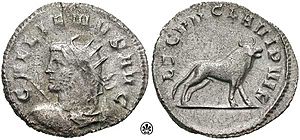Legio VII Claudia facts for kids
The Legio VII Claudia (meaning Claudius' Seventh Legion) was a famous legion that served in the powerful Imperial Roman army. Legions were large groups of soldiers, like an army division today. This legion was known for its loyalty and bravery throughout Roman history.
Contents
A Legion's Beginnings: With Julius Caesar
The Seventh Legion was first created by the famous Roman general Julius Caesar. He needed soldiers for his battles in a region called Cisalpine Gaul, which is now part of Italy. This legion was one of the first he formed.
The Seventh Legion fought in many important battles during Caesar's time. They were part of the fight against the Nervians, a strong tribe in Gaul. They also helped Caesar's deputy, Crassus, explore western Gaul. In 56 BC, they were involved in a campaign against the Veneti, a seafaring people.
When a great leader named Vercingetorix united many Gallic tribes against Rome, the Seventh Legion was there. They fought near a city called Lutetia (which is now Paris). They were also active at the famous Alesia, where Caesar won a major victory. After this, they helped finish the fighting among the Bellovaci tribe.
The Legio VII was one of only two legions that Caesar took with him when he invaded Britain. They played a very important part in the Battle of Pharsalus in 48 BC. This battle was a huge civil war fight between Caesar and his rival, Pompey.
Loyalty and New Names
After Caesar's time, his Legio VII was temporarily disbanded. Many of its soldiers, called veterans, settled down in a town called Capua. However, another powerful Roman leader, Octavian, soon needed soldiers. He called the veterans of the Seventh Legion back to serve again. They fought for him in the Battle of Mutina.
The legion later earned the nickname Macedonia. This name might mean they fought in the Battle of Philippi in Macedonia. Or it could simply mean they were stationed there for a while before moving to Dalmatia (modern-day Croatia).
The legion was in Dalmatia in AD 42 when a man named Lucius Arruntius Camillus Scribonianus rebelled against the Roman emperor Claudius. But the Seventh Legion refused to support the rebel. Instead, they stayed loyal to Emperor Claudius. Because of their strong loyalty, the legion received special honorary titles: Claudia pia fidelis. This means "Claudia, loyal and faithful."
Later, between AD 55 and 62, the Legio VII Claudia was moved to a new province called Moesia (which is now parts of Serbia and Bulgaria). They were sent there to replace another legion that had moved to Syria.
The Year of Four Emperors and Beyond
In AD 69, Rome went through a very difficult time called the Year of Four Emperors. During this year, several different emperors tried to take power. The Legio VII Claudia followed the lead of another legion, the Legio III Gallica. They decided to support Vespasian as the new emperor, turning against Vitellius.
The Seventh Legion was part of the army that marched into northern Italy. They fought in the Second Battle of Bedriacum, which was a key battle in Vespasian's rise to power.
After Vespasian won and became emperor, the Legio VII Claudia was sent back to Moesia. They stayed there for a very long time. An inscription from the time of Emperor Antoninus Pius shows that the legion remained in this area. Moesia was later divided into two parts: Moesia Superior (Upper Moesia) and Moesia Inferior (Lower Moesia). The legion had its main base in Moesia Superior.
The Legio VII Claudia continued to exist until at least the end of the 4th century AD. Their important job was to guard the middle part of the Danube River, which was a vital border for the Roman Empire.
One famous soldier from Legio VII Claudia was Tiberius Claudius Maximus. He was the Roman soldier who brought the head of Decebalus, the Dacian king, to Emperor Trajan. This happened during the Roman conquest of Dacia.
See also
- List of Roman legions



